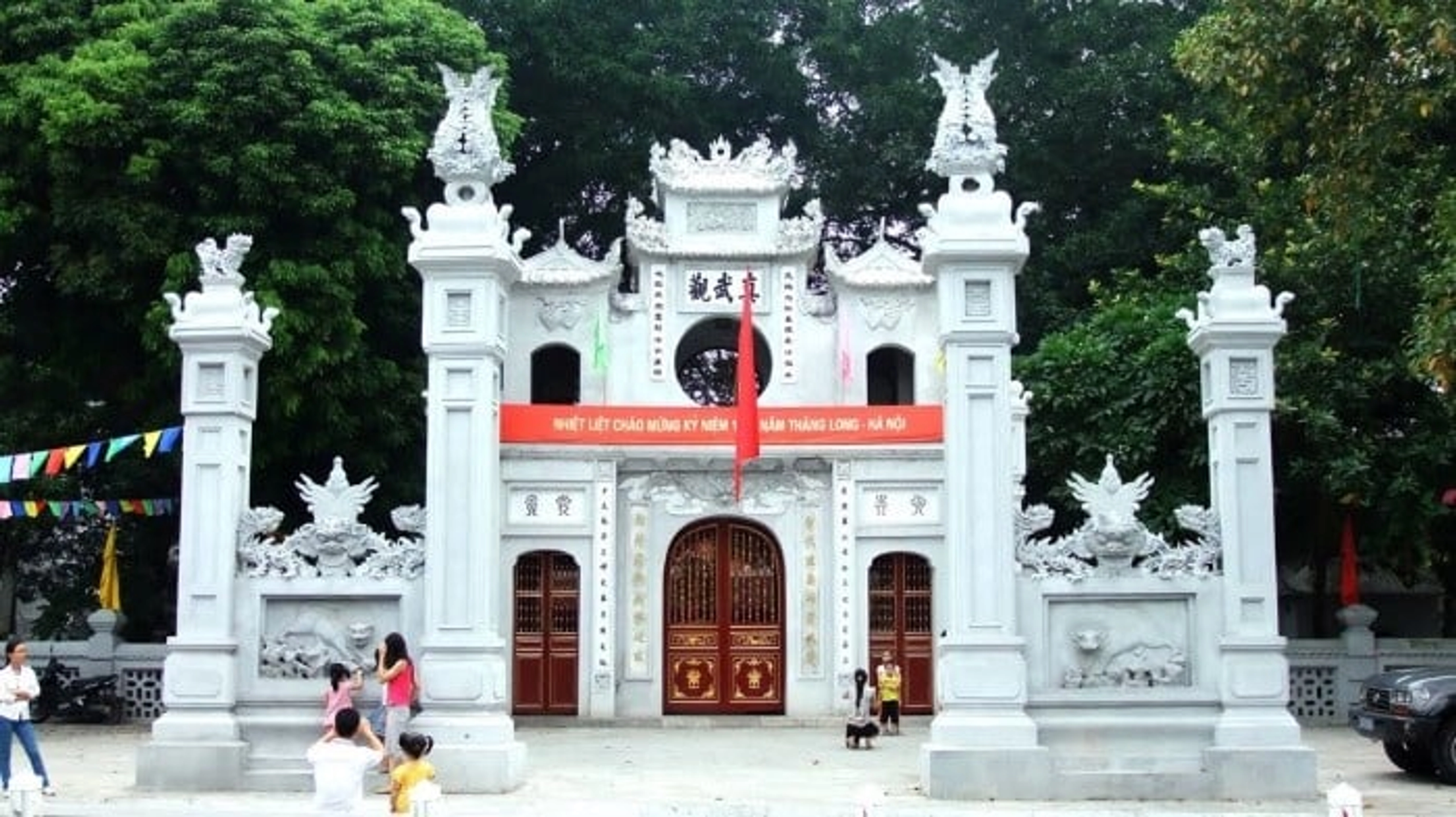

Participating in religious ceremonies and praying for luck has long been an indispensable part of Vietnamese culture. Join BDATrip to discover the attractive spiritual destinations in the capital Hanoi!
Quan Su Pagoda was built in the 15th century. It used to be a place to welcome southern envoys and has now become a pagoda that both worships Buddha and serves as a place of protection for the people and the royal court. The pagoda's architecture is a perfect combination of traditional Northern art, with a three-story roof, a majestic bell tower, surrounding corridors, and a tall and wide main hall. Inside, the pagoda is solemn with splendid gilded statues of Buddha and Bodhisattva, along with the presence of national monk Minh Khong and Monsignor.
Not only is it a place of worship, Quan Su Pagoda is also the cultural and spiritual center of Vietnam. Since 1981, the pagoda has become the headquarters of the Vietnam Buddhist Sangha, where many important Buddhist and cultural events take place. Visitors can participate in traditional ceremonies, enjoy cultural activities, participate in the longevity ceremony, and pray for peace. In addition, the pagoda also has a hall, lecture hall, Buddhist library and international living room, serving the purpose of training and propagating Buddhist teachings.
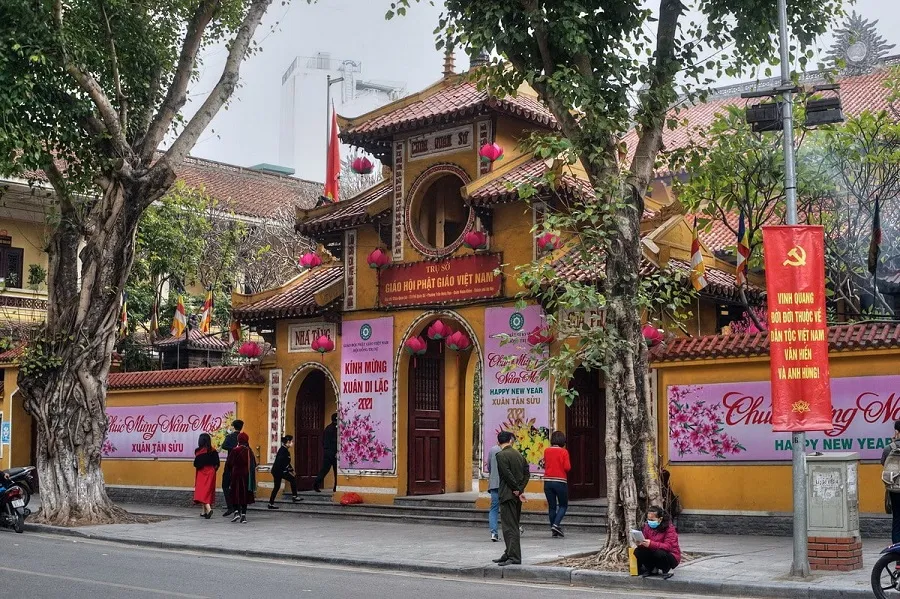
Quan Su Pagoda is an attractive spiritual and cultural tourist destination. Visitors here can admire the ancient architecture, feel the peaceful and serene atmosphere of the temple. Visitors can also participate in Buddhist activities such as Buddha ceremonies, chanting, meditation or listening to dharma talks. Quan Su Pagoda is a great place for visitors to seek peace and harmony in life.
Tran Quoc Pagoda built in 541 AD, the pre-Ly Dynasty has a history of nearly 1,500 years and is considered the oldest in Thang Long - Hanoi, the pagoda is located at 46 Thanh Nien Street, Truc Bach Street, Tay Ho District, Hanoi. Tran Quoc Pagoda, originally known as Khai Quoc since the Pre-Ly Dynasty, went through many relocations and name changes before officially being given its current name under the reign of King Le Hy Tong. Known as a temple of the Northern sect, Tran Quoc Pagoda is not only a place to worship Buddhas such as Shakyamuni Buddha, Guan Yin Buddha and Amitabha Buddha, but also a place to honor the national teacher. Minh Khong of the Ly dynasty and Monsignor.
Not only serving as a sacred place for prayer, Tran Quoc Pagoda is also an important cultural and spiritual heritage of Vietnam. This is the venue for many Buddhist cultural and religious events, including festivals such as Vu Lan Festival, Buddha's Birthday, Requiem Ceremony, and many other activities. Every year, the pagoda attracts thousands of Buddhists and tourists to participate in events with many meaningful activities such as float processions, welcoming Buddha relics, releasing balloons and doves to pray for peace. In addition, the temple also has halls, lecture halls, Buddhist libraries and international living rooms, reflecting the integration of Buddhist culture into modern life.

The architecture of Tran Quoc Pagoda has a three-entrance gate, corridors on both left and right sides, the main shrine and other rooms. Each floor has a wide step and a clay Buddha statue. The tower was built in 1842 following the architectural style of the Ly - Tran dynasties. Stupa Tower is the symbol of Tran Quoc Pagoda and is also one of the unique Buddhist architectural works of Vietnam.
The pagoda was ranked in the Top 10 most beautiful pagodas in the world by Fox News (USA). The pagoda also attracts many special visitors, such as US President Barack Obama in 2016. Tran Quoc Pagoda is an indispensable destination when traveling to Hanoi, where you can admire the beauty of architecture, landscape and learn about the history, culture and religion of Vietnam.
Quan Thanh Temple built in 1010 during the early period of the Ly dynasty, this temple is a place to honor Huyen Thien Tran Vu, one of the four gods protecting the four directions of the ancient capital Thang Long. Known by the literal name Tran Vu Quan, also known as Chan Vu Quan or Quan Thanh Temple, the temple possesses a harmonious architecture, the crystallization of Vietnamese and Chinese culture. The architecture of Quan Thanh Temple includes three entrance gates, three layers of front altar, middle altar, harem, and artistic wood carvings.
Inside the temple, the highlight is the bronze statue of Tran Vu, a majestic and attractive work, weighing 4 tons, born in 1677. The statue has a square face, cold eyes, and flowing hair. and a long beard, the appearance of a god dressed as a Taoist, sitting on a stone platform, with his left hand holding a fist and his right hand supporting a snake-wrapped sword. This is a symbol of the sophistication of Vietnamese bronze casting art, spanning three centuries. In addition, the worship house also keeps a smaller statue, the image of Mr. Trum Trong, who commanded the process of casting the statue of Tran Vu.
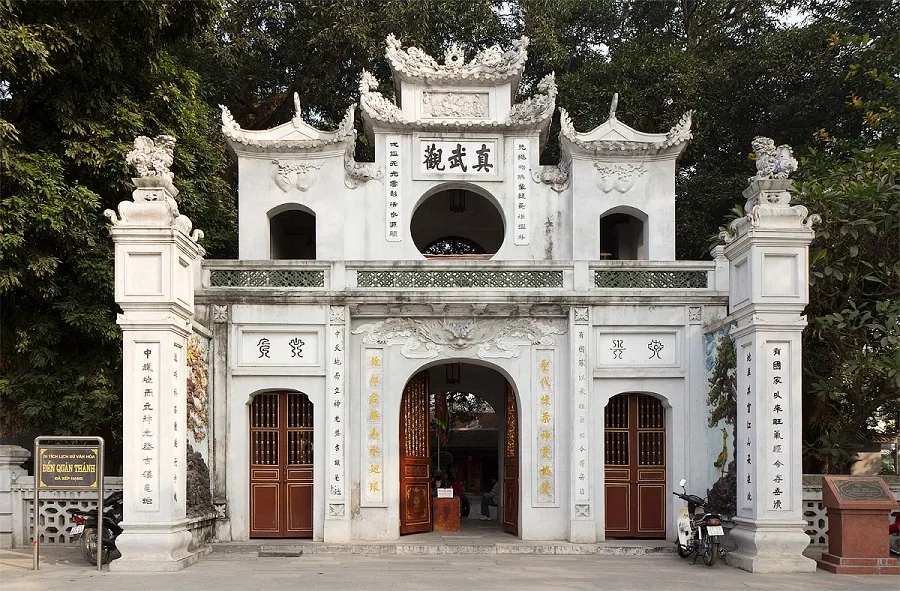
Quan Thanh Temple is not only a place for prayers but also a valuable cultural and spiritual heritage of the country. The temple regularly organizes many cultural and religious events, such as the Vu Lan Ceremony, Buddha's Birthday Ceremony, the Requiem Ceremony, the Three Jewels Refuge Ceremony, the Mountain Alms Offering Ceremony, and the Prison Door Opening Ceremony. These festivals attract thousands of Buddhists and tourists to attend, along with meaningful activities such as float processions, welcoming Buddha relics, releasing balloons, doves praying for peace, and other activities. Performing arts and rituals, performing rituals.
The temple also organizes festivals on the 3rd day of the 3rd lunar month every year, attracting many people and tourists to pray and worship. Quan Thanh Temple is also one of the places chosen as the setting for many famous movies such as “The Judge”, “Go Home” or “Living with Mother-in-law”.
The Temple of Literature - Imperial Academy is located at 58 Quoc Tu Giam, Dong Da District, Hanoi. Built in 1070 under the reign of King Ly Thanh Tong, the Temple of Literature is not only a place to worship Confucius and Confucian masters, but also the first royal school. Quoc Tu Giam, founded in 1076, was the first university for children of kings and nobles, later opening its doors to outstanding commoners.
Prominent in this architectural complex are the doctoral steles recording the names of 1,304 people from 1484 to 1780, and the Khue Van Cac - a unique architectural work and a cultural symbol of Hanoi, built in 1805. Architecture of the Temple of Literature - Quoc Tu Giam blends Vietnamese and Chinese styles, with pre-sacrifice works, middle sacrificial works, harem works, and wood carvings.

The Temple of Literature - Imperial Academy is a tourist attraction for domestic and foreign tourists. Here, visitors can not only learn about the history of Vietnam, culture and education of Vietnam, but also enjoy a peaceful and poetic space in the heart of the bustling city. Visitors can admire the beautiful architectural works, take souvenir photos, listen to stories about celebrities or participate in cultural activities here.
Perfume Pagoda is a prominent spiritual tourist destination of Vietnam, located in My Duc district, Hanoi city. The pagoda was built on a large scale around the end of the 17th century. According to historical records, the pagoda was started during the reign of King Le Huy Tong (1680 - 1704). After being restored in 1989, it is not only famous for its history related to Princess Dieu Thien but also has the title "The First Cave in the World" from Lord Tinh Do Vuong Trinh Sam.
Every year, Huong Pagoda holds a festival with religious and cultural activities, attracting thousands of Buddhists and tourists. Ceremonies such as Vu Lan, Buddha's Birthday, and alms-giving alms offerings take place along with Van singing, Cheo singing, and interesting experiences such as boating on the Yen stream, creating a special attraction. Perfume Pagoda is not only a spiritual destination but also a convergence of Vietnamese folk culture, reflecting the harmony between spirituality and nature.
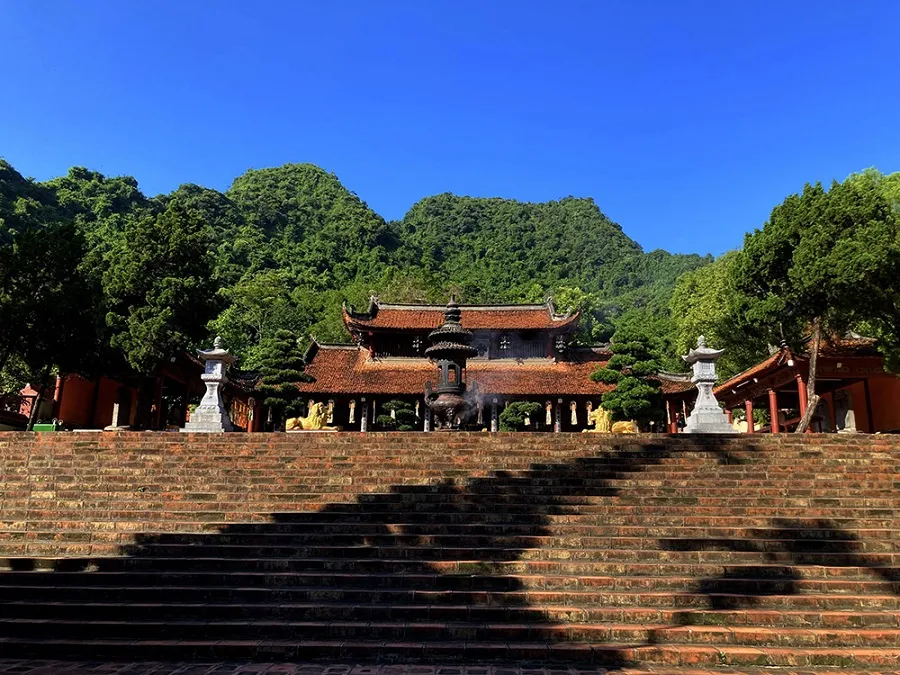
The architecture of Huong Pagoda represents the harmony between nature and humans. The pagodas are built in traditional Vietnamese architectural style, with red tile roofs, white wooden columns, door frames and altars decorated with beautiful patterns. The pagodas are arranged interspersed in the green mountains and forests, creating a lively and romantic landscape painting.
Perfume Pagoda is a destination that attracts millions of domestic and foreign tourists every year. Coming to Perfume Pagoda, visitors can not only admire the relics, feel the graceful beauty and rich flavors of Vietnam's mountains and rivers, but can also experience unique cultural and spiritual activities such as : take a boat across the Day River, take the cable car up the mountain, pay respects to Buddha and pray for peace, watch folk performances such as: ca tru, cheo, quan ho... Perfume Pagoda is also a source of inspiration for many literary works - the art of Vietnamese writers, poets and artists.
One Pillar Pagoda is a unique pagoda in the capital Hanoi, with the architecture of a lotus flower rising above the water. Built in the 11th century under the reign of Ly Thai Tong, this pagoda is uniquely designed with a sturdy stone pillar supporting the square Lotus pedestal, symbolizing the lotus flower - the symbol of purity in Buddhism. teacher. Inside, the pagoda is solemn with a gilded statue of Guanyin Buddha, with a thousand eyes and a thousand hands, exuding beauty and majesty.
The pagoda's architecture is a harmonious combination of traditional Vietnamese art and Chinese style, shown in the curving red tile roof and the image of "two dragons flanking the moon" on the top of the roof, symbolizing balance. yin and yang and fertility. One Pillar Pagoda is not only a place of religious worship but also the center of many cultural and spiritual events, from traditional ceremonies to community activities such as organizing poetry festivals and praying for good luck for scholars.
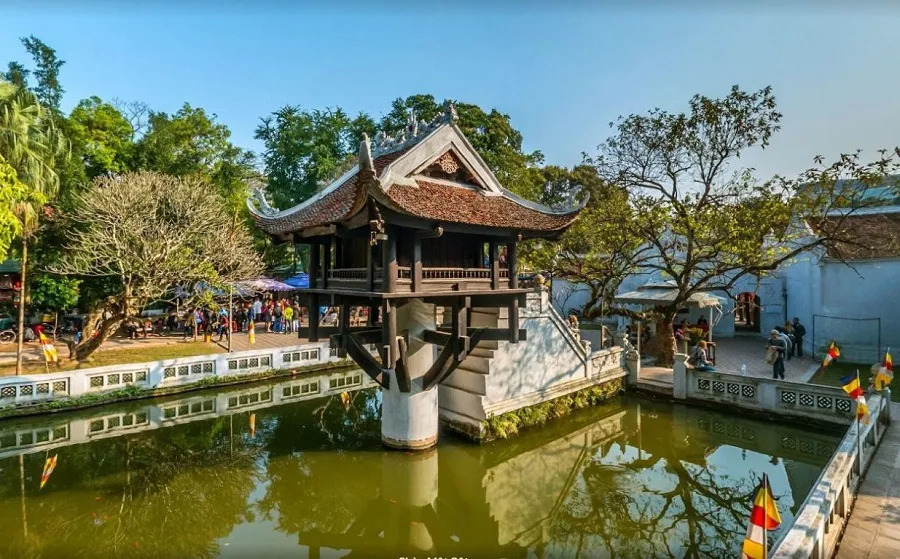
One Pillar Pagoda is a symbol of Buddhist faith and Vietnamese national history. The pagoda also attracts millions of visitors from home and abroad to visit and pray. Many people believe that the pagoda has miracles, and can bless those who wish to have children or peace.
One Pillar Pagoda is one of the national monuments recognized by the Ministry of Culture - Information in 1962. The pagoda was also chosen as one of the symbols of Hanoi capital, and was printed on the 5000 VND metal coin of Vietnam. One Pillar Pagoda is not only a unique and beautiful pagoda, but also a testament to the resilience and perseverance of the Vietnamese people throughout history.
I hope that the places in this article will give you more interesting choices for stourist attractions in Hanoi with your loved ones!
Copyright © 2022 BDATrip.com | All rights reserved.